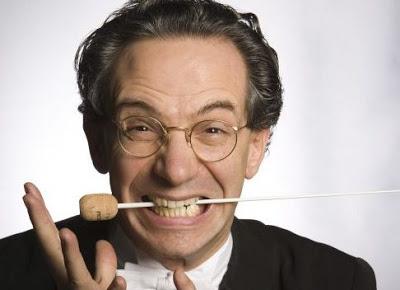by Paul J. Pelkonen

Fabio Luisi apparently demonstrating the proper way to eat one's baton.
Photo by Barbara Luisi.
This was an ambitious program. It started with the first Carnegie Hall performance of In tempus praesens, ("In the present time") the second violin concerto from the pen of Russian-Tatar composer Sofia Gubaidulina. Here, the solo part was taken by Met concertmaster David Chan. In tempus praesans begins with a deceptively simple series of wide intervals on the solo violin: less than a melody but more than a tone-row. From there, the piece set the soloist against the tuttis from a very large orchestra, minus its violin section.
Judging from a first listen, this piece folk influences of central Russia and the ancient, pagan ceremonies that also inspired Stravinsky's Rite. Huge, slab-like constructs were laid down by the violin-less string section. They seemed to rise up and impede the soloist's progress through the score. Colorful percussion and adventurous tonalities make one think of the late works of Scriabin, pushing the boundaries of tonality in the quest for mystic understanding through music.
One these geometric structures, set somewhere in the middle of this contiguous, 30-minute work presented a huge "pyramid" of sound. With exotic percussion and heavy brass dressed for sacrifice to an unknown musical god. Sharp, panicked cries from the extreme high and low ends of the violin's range were answered back by grim chords from the Wagner tubas, inter-cut with jabs of exotic percussion. Finally, the violin "escaped," zigzagging to freedom in a display of virtuoso ability from Mr. Chan.
The second half of the program opened with Beethoven's Fifth Piano Concerto, which despite the objections of musicologists (and possibly the composer himself) will always bear the nickname "Emperor." Here, the soloist was Yefim Bronfman, the powerful Russian whose massive, bearlike frame belies a delicacy of touch. Mr. Bronfman and Mr. Luisi created poetry in the massive opening movement, reaching deep for the meaning of Beethoven's music. The composer starts the soloist and orchestra on equal terms, forcing them to work together without flashy cadenzas to create a powerful, and deeply human statement that, in 1809, turned the whole concept of the concerto on its ear.
The second movement featured a gentle, almost caressing touch from Mr. Bronfman, as the orchestra spun soft, glowing support for his solo piano line. The pianist led the dance in the final Rondo, playing with a bright, muscular tone that was answered brilliantly by the orchestra and Mr. Luisi. Of particular note was the fine balance between the string sections, which tossed Beethoven's supporting chords back and forth adroitly, generating a powerful climaxes in the final repetitions of the round theme.
As if these two mighty concertos weren't enough, Mr. Luisi followed with Stravinsky's 1945 arrangement of the Firebird Suite. The conductor emphasized the composer's text, eliminating many of the mannerisms that have crept into performance of this favorite score in the last century. As a result, the Carnegie audience heard some thrilling new sounds not normally associated with this work. This cerebral take on the work was played with great clarity and beauty of tone, particularly in dusky tones of the cellos and the horn solo by principal Joseph Anderer.
The final celebratory dance of the Firebird remains the best known section of the score, a avalanche of strings and brass that has been used to open sporting events, rock concerts and even as the end of a ballet. Here, Mr. Luisi had the orchestra play these descending figures with a sharp-edged, tight sound that is apparently the original intent. The strings played the familiar descending chords using only "downward" strokes, creating a "crunch" sound that while different, proved as compelling as what is usually heard.

